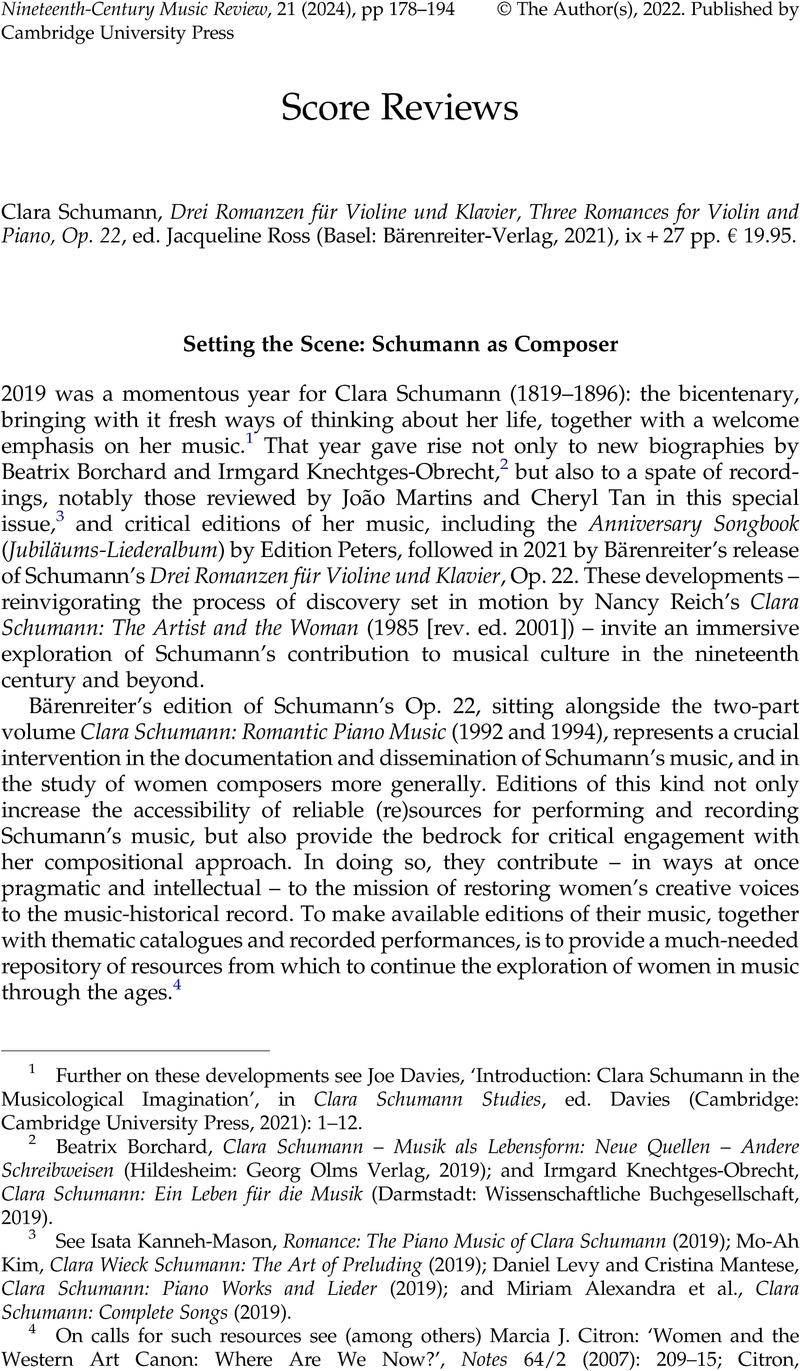No CrossRef data available.
Article contents
Clara Schumann, Drei Romanzen für Violine und Klavier, Three Romances for Violin and Piano, Op. 22, ed. Jacqueline Ross (Basel: Bärenreiter-Verlag, 2021), ix + 27 pp. € 19.95.
Review products
Published online by Cambridge University Press: 27 September 2022
Abstract

- Type
- Score Review
- Information
- Nineteenth-Century Music Review , Volume 21 , Special Issue 1: Clara Schumann: Changing Identities and Legacies , April 2024 , pp. 178 - 183
- Copyright
- Copyright © The Author(s), 2022. Published by Cambridge University Press
References
1 Further on these developments see Davies, Joe, ‘Introduction: Clara Schumann in the Musicological Imagination’, in Clara Schumann Studies, ed. Davies (Cambridge: Cambridge University Press, 2021): 1–12CrossRefGoogle Scholar.
2 Beatrix Borchard, Clara Schumann – Musik als Lebensform: Neue Quellen – Andere Schreibweisen (Hildesheim: Georg Olms Verlag, 2019); and Knechtges-Obrecht, Irmgard, Clara Schumann: Ein Leben für die Musik (Darmstadt: Wissenschaftliche Buchgesellschaft, 2019)Google Scholar.
3 See Isata Kanneh-Mason, Romance: The Piano Music of Clara Schumann (2019); Mo-Ah Kim, Clara Wieck Schumann: The Art of Preluding (2019); Daniel Levy and Cristina Mantese, Clara Schumann: Piano Works and Lieder (2019); and Miriam Alexandra et al., Clara Schumann: Complete Songs (2019).
4 On calls for such resources see (among others) Citron, Marcia J.: ‘Women and the Western Art Canon: Where Are We Now?’, Notes 64/2 (2007): 209–15CrossRefGoogle Scholar; Citron, ‘A Bicentennial Reflection: Twenty-five Years with Fanny Hensel’, in ‘Fanny Hensel (née Mendelssohn Bartholdy) and her Circle’: Proceedings of the Bicentenary Conference, Oxford, July 2005’, ed. Susan Wollenberg, Nineteenth-Century Music Review 4/2 (2007): 7–20; and Susan Wollenberg, ‘“Master of her Art”: Fanny Hensel (née Mendelssohn Bartholdy), 1805–1847’, Ad Parnassum: A Journal of Eighteenth- and Nineteenth-Century Instrumental Music 3/6 (2005): 33–44.
5 See Stefaniak, Alexander, Becoming Clara Schumann: Performance Strategies and Aesthetics in the Culture of the Musical Canon (Bloomington: Indiana University Press, 2021)CrossRefGoogle Scholar; and Natasha Loges, ‘From Miscellanies to Musical Works: Julius Stockhausen, Clara Schumann, and Dichterliebe’, in German Song Onstage: Lieder Performance in the Nineteenth and Early Twentieth Centuries, ed. Loges and Laura Tunbridge (Bloomington: Indiana University Press, 2020): 70–86.
6 For more on Op. 7, see Joe Davies, ‘Clara Schumann and the Nineteenth-Century Piano Concerto’, in Clara Schumann Studies, 95–116, at 108–12. Further on interiority see Nicole Grimes, ‘Formal Innovation and Virtuosity in Clara Schumann's Piano Trio in G minor, Op. 17’, in Clara Schumann Studies, 139–64; Stefaniak, Alexander, ‘Clara Schumann's Interiorities and the Cutting Edge of Popular Pianism’, Journal of the American Musicological Society 70/3 (2017): 697–765CrossRefGoogle Scholar; and Ronyak, Jennifer, Intimacy, Performance, and the Lied in the Early Nineteenth Century (Bloomington: Indiana University Press, 2018)CrossRefGoogle Scholar.
7 Katharina Uhde and R. Larry Todd, ‘Contextualizing Clara Schumann's Romanzen’, in Clara Schumann Studies, 165–86, at 175–85.
8 All quoted material is taken from a private interview with Lorna Griffitt, conducted at the University of California, Irvine, on Wednesday 1 June 2022. Further insights into Griffitt's engagement with Schumann can be found at https://music.arts.uci.edu/launching-clara-schumann-studies-celebrating-women-music.
9 See Goertzen, Valerie Woodring, ‘Clara Wieck Schumann's Improvisations and Her “Mosaics” of Small Forms’, in Beyond Notes: Improvisation in Western Music of the Eighteenth and Nineteenth Centuries, ed. Rasch, Rudolph (Lucca: Brepols, 2011): 153–62Google Scholar; and Goertzen, Valerie Woodring, ‘Setting the Stage: Clara Schumann's Preludes’, in In the Course of Performance: Studies in the World of Musical Improvisation, ed. Nettl, Bruno and Russell, Melinda (Chicago: University of Chicago Press, 1998): 237–60Google Scholar.
10 These terms are borrowed from Webster, James, ‘The Rhetoric of Improvisation in Haydn's Keyboard Music’, in Haydn and the Performance of Rhetoric, ed. Beghin, Tom and M., Sander Goldberg (Chicago: University of Chicago Press, 2007): 172–212Google Scholar, at 176.





